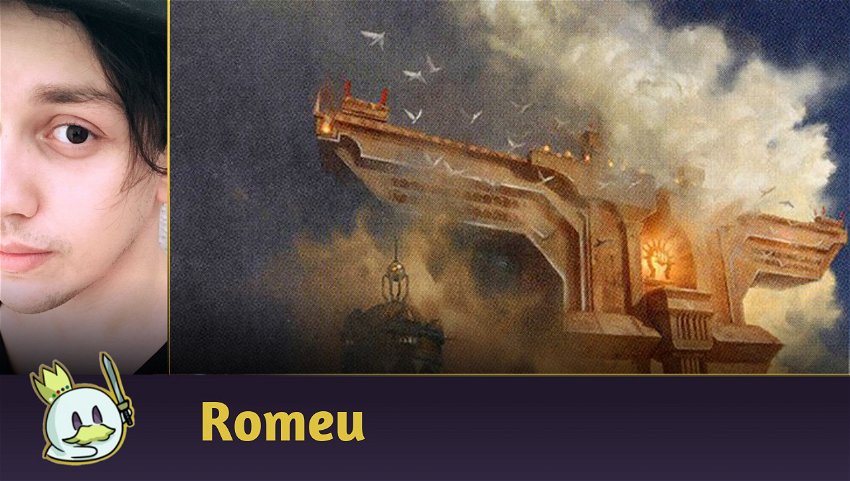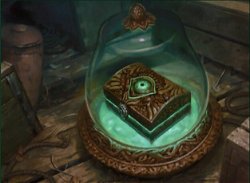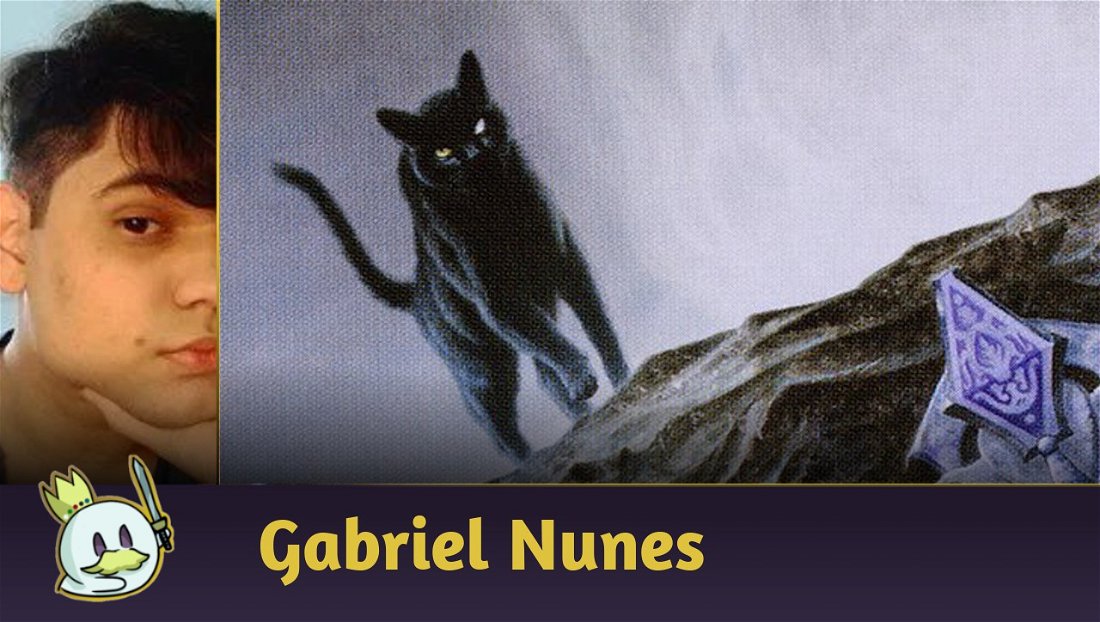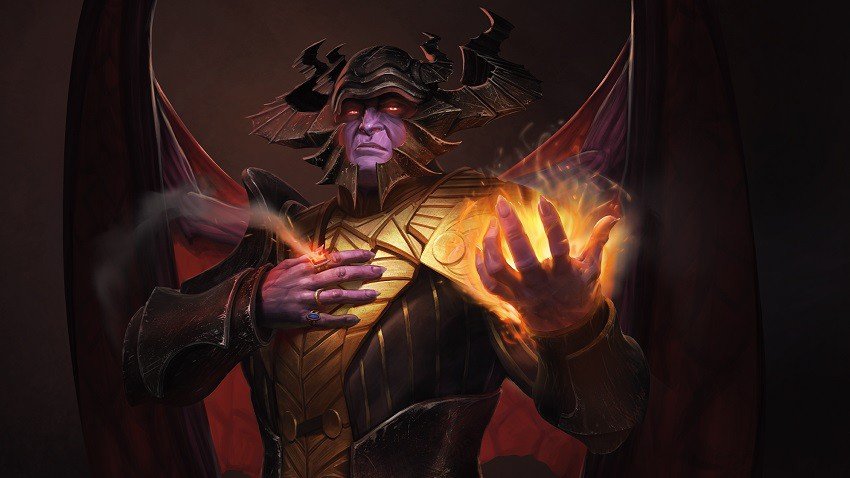Do you remember War of the Spark?
The Planeswalkers-focused set that started the F.I.R.E. philosphy and ended Bolas' arc was released just three years ago, and was a huge success for containing a huge amount of individually good cards that changed the competitive landscape of the game forever, but with so many cards with such high power and many people opening booster packs, it was only natural, when I was working at a local store, to see their frustration for opening certain cards, especially Parhelion II.
Ad

Parhelion II was bad in pretty much every way: Its mana cost was too high even for limited (although if you cast and crewed the vehicle at least once, you'd probably win the game), its crew cost wasn't easily achievable and there was simply no room for a strategy involving a massive eight-mana battleship.
It is more than obvious that no one suspected or expected that, three years later, a new set would bring enough support to make Parhelion II the centerpiece of a new archetype.

Greasefang, Okiba Boss essentially allows you to cheat on the cost of War of the Spark's vehicle if it is put into your graveyard, then return it to the battlefield with Haste, crew it with Greasefang itself, and then attack the opponent, creating two 4/4 Angel tokens next to the vehicle, and if neither creature is blocked, it deals a total of 13 damage, and force the opponent to deal with the tokens on the next turn, or lose the game.
Despite the amount of parts needed to really work (Parhelion II in the graveyard, creatures to crew the vehicle, and lack of interaction), the combo is powerful enough on its own to establish new archetypes in the format, as we've seen in recent weeks with the Esper Parhelion.
However, players are starting to experiment with new ramifications and possibilities with it, looking for the ideal way to add speed and consistency to the point where the archetype adapts to a Metagame that has been relatively streamlined and less interactive with Neon Dynasty's release, and it is in this context that we are introduced to Abzan Parhelion, used by the player canepis16 to reach the Top 8 of the Pioneer Challenge!
Decklist Analysis
While Esper Parhelion has a strategy that is similar to Combo-Control, looking to interact with the game while gathering the necessary pieces, and which, particularly, I think it doesn't do well in this category because Greasefang + Parhelion doesn't actually win the game on its own on the same turn the combo is executed, the Abzan Parhelion fits almost entirely into the Combo category, being focused on having both pieces in the graveyard and/or in hand to end the game as soon as possible, and each of the included cards has the sole purpose of adding consistency, or protecting the combo.
This creates a situation where the archetype is not as good and efficient at interacting or playing very long matchups, but has a much greater resilience in executing its game plan over and over again if needed, and in many ways, the composition of that list reminds me of the old Soulflayer decks that came out early in the format, but with a smaller amount of absolutely useless cards and fewer “bad” pieces to draw, as multiple copies of Greasefang, Okiba Boss can be used to return more copies of Parhelion II or Esika's Chariot that have been placed in the graveyard with any of the self-mill effects.
At the end of the day, I think that Abzan Parhelion ends up gaining an advantage in the current Metagame over the Esper variants by playing less “fair” than its predecessor, ensuring better game development in a format that, today, seems more aimed at games where each player attempts to perform their absurd interaction or explosive play before the opponent.
Ad
Maindeck
The Combo

As already explained above, the combination of Greasefang, Okiba Boss and Parhelion II can win the game over the course of two turns if the opponent fails to interact with any of the pieces, and while Parhelion II doesn't do much on its own and needs to be in the graveyard to be useful, Greasefang can also be used to return and crew Esika's Chariot from the graveyard to the battlefield, adding an insane amount of power to the board with a single card.
The Self Mill

In the Abzan combo, we don't have as many efficient ways to draw and discard cards as we have in the Esper versions, but the list makes up for that by using a powerful Self-Mill package that allows you to put a significant number of cards into the graveyard for a very low cost, increasing the chances of having a vehicle to reanimate with Greasefang, Okiba Boss, while other spells can help call upon the deck's centerpiece if it is put into the graveyard.
Grisly Salvage is probably the best among them, as it lets you select a creature if necessary, but Satyr Wayfinder and Stitcher's Supplier work well as early-game blockers, and also speeds up Tasigur, the Golden Fang.
The Recursion

Since there are legitimate chances that you could put Greasefang, Okiba Boss into the graveyard with any Self-Mill effect, it's important to have access to cards that allow you to return it to the battlefield or your hand from the graveyard.
Blood Fountain is the cheapest but least potent of the recursions, and the Blood token it creates also allows you to discard copies of Parhelion II you've drawn over the course of the game.
Can't Stay Away has never seen much play in any competitive format, but it works well on this list as a pseudo Unburial Rites for Greasefang, and can be reused from the graveyard, an essential synergy with the Self-Mill cards.
Sorin, Vengeful Bloodlord is not only useful for returning Greasefang (and still remaining on the battlefield), but the fact that it gives Lifelink to your creatures can make a huge difference when attacking with a vehicle and with the tokens produced by Esika's Chariot.
The Interaction

Despite being a Combo archetype and having a multitude of pieces aimed at making it work as intended, it's practically impossible for a deck in Pioneer to play without some interactions these days, either to slow down the more aggressive archetypes or to get information and remove important pieces from the opponent's hand.
Thoughtseize is still the best one mana discard spell in the game, and it not only gives you the information you need to know how to proceed with your combo, it also removes a critical piece from your opponent's hand, whether it's a wincondition or an interaction.
Ad
Fatal Push is the best low-cost removal of the format these days and handles a significant amount of small creatures, and since you have a clear interest in blocking with creatures like Stitcher's Supplier, there aren't many problems with enabling the Revolt as well.
Finally, the lone copy of Skyclave Apparition draws attention, but is a valid target to reanimate or return to the hand with your recursion effects, creating an interaction piece that can be properly repurposed if necessary.
The Alternate Wincondition

You can't just expect the combo plan to work in every game, and it's necessary to have alternative means of establishing a win condition while the opponent worries about dealing with Parhelion II.
Esika's Chariot is one of the most powerful vehicles recently released, as it creates an immediate impact on the board by producing two tokens that can crew it, and has a significant amount of interactions with Greasefang, Okiba Boss as the vehicle will be able to attack the same turn it enters the battlefield, and will copy one of its tokens, as well as produce two more when cast the next turn after being returned to your hand, adding a total of 14 power between two turns.
Tasigur, the Golden Fang is relatively well positioned in the current Pioneer Metagame, as the most played removals currently are Fatal Push and March of Otherworldly Light, which means that a Delve threat cast in the first few turns will often have free space to apply proper pressure against the opponent, which is not too difficult for an archetype that puts so many cards into its own graveyard.
The Manabase

I don't think there's much to say about the manabase on this list, and while I have a personal preference for not running too many Pathways in three-color decks, the Darkbore Pathway playset seems a lot more reliable in this list than Overgrown Tomb or Llanowar Wastes.

Despite being considered by many the worst of the Channel Lands cycle, Takenuma, Abandoned Mire is another extra piece of recursion that the archetype has to return Greasefang, Okiba Boss from your graveyard to your hand.
Sideboard

Voice of Resurgence was once considered one of the most powerful cards released in the game, but unfortunately, it lost its space in the face of power creep and today is just an occasional piece of Sideboard against Control or archetypes that resort to a huge number of removals or Instant-Speed interactions

Collective Brutality has several uses on a single card and seems essential as an additional discard piece that is not absolutely useless against archetypes that runs small creatures, in addition to being a devastating effect against Burn when cast on the right timing, and also this is another way to discard those extra copies of Parhelion II in your hand.
Ad

Liliana, the Last Hope is still one of the most powerful Planeswalkers out there on Pioneer and handles significantly well against archetypes that rely on small creatures, but its biggest utility is definitely the potential to be an extra recursion piece and an alternate wincondition in attrition games.

One inclusion that really caught my eye, mainly due to being a four-of on the Sideboard, was Culling Ritual.
As with Modern, a significant portion of strategy in Pioneer is geared towards including Lurrus of the Dream-Den as a powerful additional attrition piece, limiting the deckbuilding space of these lists, and Culling Ritual basically punishes any Lurrus archetype by basically clearing the opponent's board while keeping your permanents in play, plus adding enough mana to cast an extra spell or two.
Another important point of the inclusion of this sweeper is the amount of Oni-Cult Anvil decks that have appeared in the Metagame since Kamigawa: Neon Dynasty came out.

Which brings us to the other sideboard option coming from Strixhaven, Fracture, functioning as another powerful Metacall in a format that is moving away from strategies revolving around creatures in favor of artifacts and Planeswalkers, and being able to handle Oni-Cult Anvil and Karn, the Great Creator with a single card is a valid and relevant option, although I'm not so sure how influential the extra land drop really is to the point of Assassin's Trophy not being a more comprehensive inclusion.

Legion's End is another comprehensive answer against small creature decks, and one that also deals with the occasional recursive threat, like the ones we see in Mono-Black Aggro and the Rakdos variants that have been popping up.
Alternate Card Choices

Since this is a strategy that favors the Self-Mill and naturally wants the Artifact type in its graveyard, it is possible that in a scenario more focused on grindy matchups, Abzan Parhelion wants to go for a game plan that is also focused on Delirium, with the inclusion of cards that naturally interact with the archetype's proposal, such as Grim Flayer and Traverse the Ulvenwald, in addition to some payoffs that can also feed your game plan, like Mindwrack Demon.
The problem with this proposal, however, is that it is deviating from the main objective of the list, reducing its consistency of executing its plan A to obtain a more efficient plan B, but which is also equally fragile to the generic answers that would normally harm Abzan Parhelion.

Despite increasing the amount of potentially useless cards in your hand at the beginning of the game, Delve creatures are very well positioned in the format currently as the main removal in the Metagame cannot easily reach them, and it is possible to take better advantage of this by adding an extra copy of Tasigur, the Golden Fang or even Gurmag Angler.
Ad

As for other Self-Mill cards, and I would especially consider the possibility of including Undead Butler, since it not only has a similar amount of cards to Stitcher's Supplier, but also makes it possible to resort to Greasefang, Okiba Boss if necessary.
And while I'm talking about Self-Mill effects, Gather the Pack deserves an honorable mention, despite finding it less efficient than Grisly Salvage on this list.

Given how much easier it is to cast Esika's Chariot and how absurd it is with Greasefang, it's possible that cutting a copy of the combo-kill in favor of a more consistent wincondition and that also sets up some powerful pressure alongside one of the combo pieces is a viable and more consistent option for the archetype's future.
And speaking of vehicles, let's not forget that Skysovereign, Consul Flagship can also be replayed arbitrarily alongside Greasefang, managing to deal with a large creature, or several small creatures, or even a Planeswalker, with a single ETB and attack.
The only problem with this artifact, however, is that most creatures in the deck are simply mediocre at crewing anything, and it doesn't produce its own pilots in the same way Esika's Chariot does.

Perhaps a copy or two of Mech Hangar could help with this issue, but I think the manabase is already too greedy to afford the luxury of running colorless lands.

Finally, there is a certain importance in also talking about the Sideboard, and I suppose that Assassin's Trophy can be considered in place of Fracture because it is a more comprehensive answer, but that depends on how much the extra land drop really makes a difference in most games
With Izzet Phoenix slowly returning to the Metagame, and now even more reliant on its graveyard, as the most recent lists cut the four copies of Thing in the Ice, it could be time again for black-based decks to switch back to running some copies of Go Blank on the sideboard.
Keep in mind, however, that an increase of Go Blank on the sideboards will likely also hurt Abzan Parhelion, as it is highly dependent on the graveyard to work.
Sideboard Guide
I'll leave here some of my considerations on how to sideboard and how to behave against some of the main decks of the format with the current list.
vs. Azorius Ensoul
OUT:

IN:

Azorius Ensoul is extremely agile and resilient, and doesn't usually give you enough time to capitalize on discard effects, and your best bet is to go into the combo as soon as possible because it's impossible to trade evenly against them.
Casting a Culling Ritual at the right time will often give you enough time to keep the game going for a few more turns and re-establish yourself with Esika's Chariot, but watch out for the possibility of the opponent to return with Lurrus of the Dream-Den or even more threats.
Ad
vs. Izzet Phoenix
OUT:

IN:

If the opponent runs Thing in the Ice, keep the Fatal Push and remove the Voice of Resurgence, also include the copy of Legion's End, and you may also want to remove a copy of Parhelion II from the maindeck, but I don't know how much I can recommend this option.
Your biggest post-sideboard enemy will likely be bounce effects such as Stern Dismissal or Otawara, Soaring City, and being able to play around them is essential. Therefore, your best option is to focus on using your discard spells to remove interaction or Delve spells, capable of quickly dominating the game.
Voice of Resurgence is significantly useful as another Plan B against Izzet Phoenix because the only way it isn't a 2-for-1 trade is with Flame-Blessed Bolt or Anger of the Gods, cards that are relatively bad against the rest of the deck or your main game plan.
vs. Rakdos Anvil
OUT:

IN:

This matchup is extremely unfavorable if you attempt to stick to your original game plan in Game 2 or 3 as the opponent will usually have too many elements to deal with the combo between maindeck and sideboard, with spells like Kolaghan's Command and By Force, so the best option I've found to play this game is to partially forgo the combo, removing copies of Parhelion II and part of the Self-Mill elements in favor of a grind-oriented game plan with Voice of Resurgence and Liliana, the Last Hope.
This is one of the matchups where I would really like a third copy of Esika's Chariot in place of the fourth Parhelion II as the Kaldheim's vehicle is a huge value engine with Greasefang, which remains at three copies as much to threaten the combo as well as for its ability to generate multiple tokens if the opponent doesn't have an answer for the Chariot.
Also, in this matchup I added an extra card to the main deck in Game 2 and 3, and this is a personal choice, you are free to remove one more card or keep an option of your choice on the sideboard.
Conclusion
Kamigawa: Neon Dynasty has definitely changed how we play a variety of formats, including Pioneer, and it's not uncommon to see artifact-oriented strategies having their spot on the Metagame since its launch.
The Abzan Parhelion is another one of the innovative ideas the new set has brought, and it probably won't be the last archetype variant with Greasefang, Okiba Boss to make results in competitive events.
Soon, I'll bring a broader analysis of the format and competitive tournaments over the last few weeks.
Thanks for reading!









— commentaires0
Soyez le premier à commenter